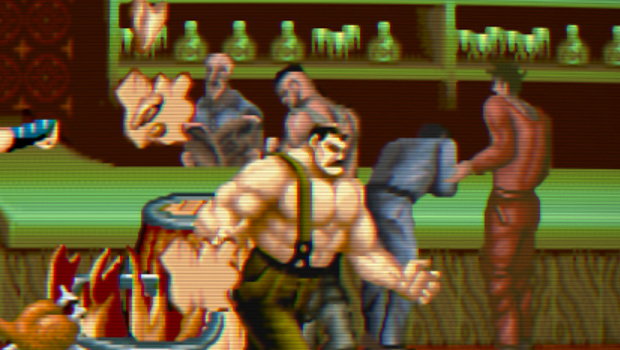While visiting with Capcom at CES, we had the opportunity to see a number of things that, as a retro gamer, made me giddy as a schoolgirl at prom. Among these is the upcoming PSN/XBLA release of Final Fight: Double Impact. The two games which come in the release, the namesake Final Fight and Magic Sword are among my favorite quarter-munchers. The latter has probably cost me upwards of a couple hundred dollars over the years.
Capcom has created an incredibly faithful port here, with an excellent attention to detail. There’s a lot of love for fans of the arcade experience poured into the games and it’s done in ways that go beyond the mechanics.
Read on past the fold for further impressions.

Final Fight: Double Impact [PSN/XBLA]
Developed by: Proper Games
Published by: Capcom
Release Date: April 2010
If you are not familiar with Final Fight, I’m not sure I know who you are anymore. Magic Sword I can forgive, but the classic street-brawling game is legendary. The game follows three heroes, Cody, Guy and Haggar, as they fight the gangs of Metro City to rescue Haggar’s daughter from the criminal overlord, Mad Gear.
The other game, Magic Sword, is a medieval fantasy where “The Great One” climbs to the top of an ancient tower to defeat the evil which resides within. A subtly complex game with exceptional level design and an interesting teammate system where NPCs who are rescued from the many dungeon cells in the tower will lend their strength to the hero, it’s an absolute classic.
I can confirm that it’s still quite satisfying to beat up the friend who can’t stay the hell out of your way in Final Fight. The games both play exactly how I remember them on their original machines1. They’re so faithful that elements which would have been added to other ports of this nature are left out. A perfect example is the lack of explanation of the power-ups in Magic Sword which must be experimented with to determine their effects.

Further impressive are the bits that were added, specifically the graphical filters which can be applied to the games. There are a few different varieties, but the show stealer is an arcade mode. This adds the original artwork from the cabinets to the sides of the screen and, to add to the realism, the screen itself is given the appearance of bowing out like a CRT monitor. It’s nothing short of beautiful to those with fond memories of playing in arcades.
Another little extra are awards for meeting criteria while playing the games. Completing the various challenges will unlock art and music. They’re neat, I suppose, giving the development team the opportunity to create extra achievement-like rewards without having to worry about restrictions set by the console manufacturers. I could take or leave the feature, but I’m certain there will be many who enjoy it.
Both titles will also have the benefit of online, 2-player cooperative play. While far from my preferred method of having someone sit on my couch (or, be still my heart, stand next to me at a machine), I can certainly see myself playing through all 100 levels of Magic Sword with people over the internet who have more patience than my friends, if such folks exist.
I knew from the moment it was announced that I would be buying this double feature. Magic Sword alone is reason for anyone to pick it up. Final Fight surprised me a bit with how well it stands the test of time, though. It’s a truly fine brawler, one worthy of its legendary status. April needs to hurry itself up so I can play again.
1 Capcom has said that the soundtrack for the games is original and done by the people responsible for music in Bionic Commando: Rearmed. While no doubt true, the fog of memory has rendered me unable to tell the difference.


